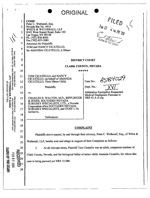Wednesday, Nov. 17, 2010 | 2 a.m.
Do No Harm: Hospital Care in Las Vegas, Part 4
- Why we suffer
- Flesh wound was so much more
- After sugery, an injury uncured
- Missouri family loses its rock
- Leaving hospital saved her life
- Where I Stand: Hospitals should examine what ails them, seek cure
- Overview of the Sun’s series on health care
- How to file a complaint
- Why Nevada’s nurses quit
Share your stories
An ongoing Las Vegas Sun investigation paints a bleak portrait of hospital care in Southern Nevada.
But according to a federal government study released Tuesday, the situation may be much worse.
A nationwide study of the medical records of 780 randomly sampled Medicare patients found that 1 in 7 of them suffered harm such as medication errors, bedsores, falls resulting in bone breaks, infections and other injuries while hospitalized in October 2008, the U.S. Health and Human Services Department reported. When extrapolated, an estimated 134,000 Medicare patients were harmed during hospital stays that single month.
In addition, about the same number of patients suffered lesser harm at hospitals, meaning their long-term health was not affected.
And in 1.5 percent of cases, patients experienced an event that contributed to their deaths, the government found, indicating that about 15,000 Medicare patients nationally die monthly as the result of being harmed in a hospital.
The study, conducted by the department’s Office of Inspector General, determined that 44 percent of the events that harmed patients were clearly or likely preventable. The physician reviewers said the events were most likely due to medical errors, substandard care and lack of patient monitoring and assessment.
The hospital care required as a result of these events cost Medicare $324 million for that month, the government found — and an estimated $4.4 billion in fiscal year 2009, numbers that do not include the cost of follow-up care.
The Inspector General’s report not only echoes the Sun’s findings in its investigation, “Do No Harm: Hospital Care in Las Vegas,” but suggest that the problem is even greater than the Sun found.
The Sun examined 425,000 billing records in 2008 and 2009 to identify instances where patients were injured or infected in hospitals.
The newspaper identified 3,689 cases of preventable harm that could be categorized as sentinel events, meaning Nevada law requires them to be reported to the state.
During those same two years, all Nevada hospitals reported just 402 sentinel events.
Lisa McGiffert, who directs the Safe Patient Project for the nonprofit Consumers Union, said the federal report makes it clear that the number of patients being harmed in hospitals is far greater than hospitals have acknowledged.
“It’s pretty apparent that the self-reporting of the medical community is not producing those kinds of numbers,” she said Tuesday. “This is definitely more realistic and validates what many of us have thought — that this is a much greater problem than the health care system has been willing to admit.”
As a result of the Sun’s findings, Nevada health authorities have duplicated the Sun’s examination of billing records and are conducting a case-by-case analysis of medical records to determine whether the hospitals underreported sentinel events. The hospitals may be fined for underreporting.
The authors of the federal study noted Tuesday, as has the Sun previously, that there is no national system to report adverse hospital events, and no federal standards for state systems.
In its investigation, the Sun found that at the 13 acute-care hospitals in the Las Vegas Valley in 2008-09, there were:
• 710 surgical accidents.
• 2,010 cases where patients were infected with lethal bacteria.
• 969 cases of injuries such as bloodstream infections involving central-line catheters, advanced-stage pressure sores and postoperative falls.
The Sun noted at the time that its findings were a starting point for investigation, because only a close look at medical records would generate a complete picture of the problem.
The Inspector General’s study is the first to obtain a statistically valid national incidence rate for adverse events in a hospitalized population. Previous estimates had extrapolated data from more limited studies.
The Sun also noted that its findings begged for comparison with other regions, but because there are no standardized public reporting methods, it is not possible to make such comparisons.
The federal report does not delve into the problem on a hospital-by-hospital basis, which would be the kind of transparency that the Sun has delivered in its investigation. .
Most hospitals aggressively avoid public disclosure of patient harm. When the Sun collected and analyzed the billing data, most hospital officials refused to comment.
That silence is prompted in part because hospitals worry about malpractice lawsuits.
The Sun has found that by many indications, hospitals seem reluctant to learn from their mistakes. The authors of the Inspector General’s report say hospitals need to step up:
“Because many adverse events we identified were preventable, our study confirms the need and opportunity for hospitals to significantly reduce the incidence of events.”
The report’s authors recommend, among other goals, that the Centers for Medicare and Medicaid Services as well as the Agency for Healthcare Research and Quality establish guidelines for hospitals to report adverse events, develop prevention strategies and measure health care quality.
Dr. Tracey Green, Nevada’s chief health officer, said she was surprised by the enormity of the problem involving adverse hospital events identified in the federal report.
“I look at these numbers as a starting point for improvement,” Green said Tuesday.



Join the Discussion:
Check this out for a full explanation of our conversion to the LiveFyre commenting system and instructions on how to sign up for an account.
Full comments policy